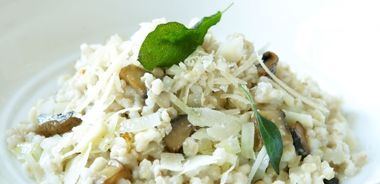Barley Risotto

Barley is a much underused heritage grain that’s just waiting to be rediscovered. This super whole grain is one of the richest sources of both soluble and insoluble fibre.
Insoluble fibre keeps things moving through your gastrointestinal tract (GI), and soluble fibre mixes with liquid, binds to fatty substances, and escorts them out of your body, helping reduce bad cholesterol in the process. So embrace the grain and start barley risotto-ing.
2 tsp (10 mL) organic extra-virgin olive oil
2 organic onions, diced
2 large portobello mushrooms or 2 cups (500 mL) shiitake mushrooms, coarsely chopped (If using portobellos, scrape out black membranes and discard before chopping)
3 cloves garlic, minced
3/4 cup (180 mL) organic pot barley
2 1/2 cups (625 mL) organic low-sodium chicken or turkey stock
1/4 cup (60 mL) Parmigiano-Reggiano cheese, grated
Heat a medium saucepan with a tightly fitting lid over medium heat; add oil and onions and saute for 1 minute. Add mushrooms and garlic; continue sauteing for 1 minute. Add pot barley and stock, stir, bring to the boil, and reduce heat to simmer. Cover and simmer for 50 minutes or until done. Remove from heat; gently stir in the Parmigiano-Reggiano. Garnish with shavings of fresh Parmesan. Top with sage leaves that have been lightly crisped in hot oil.
Makes 4 - 1 cup (250 mL) servings.
Each Serving Contains:
200 calories; 8 g protein; 6 g total fat (2 g sat fat, 0 g trans fat); 44 g carbohydrates; 2 g fibre; 480 mg sodium.
source: "Easy on the Tummy", alive #312, October 2008




